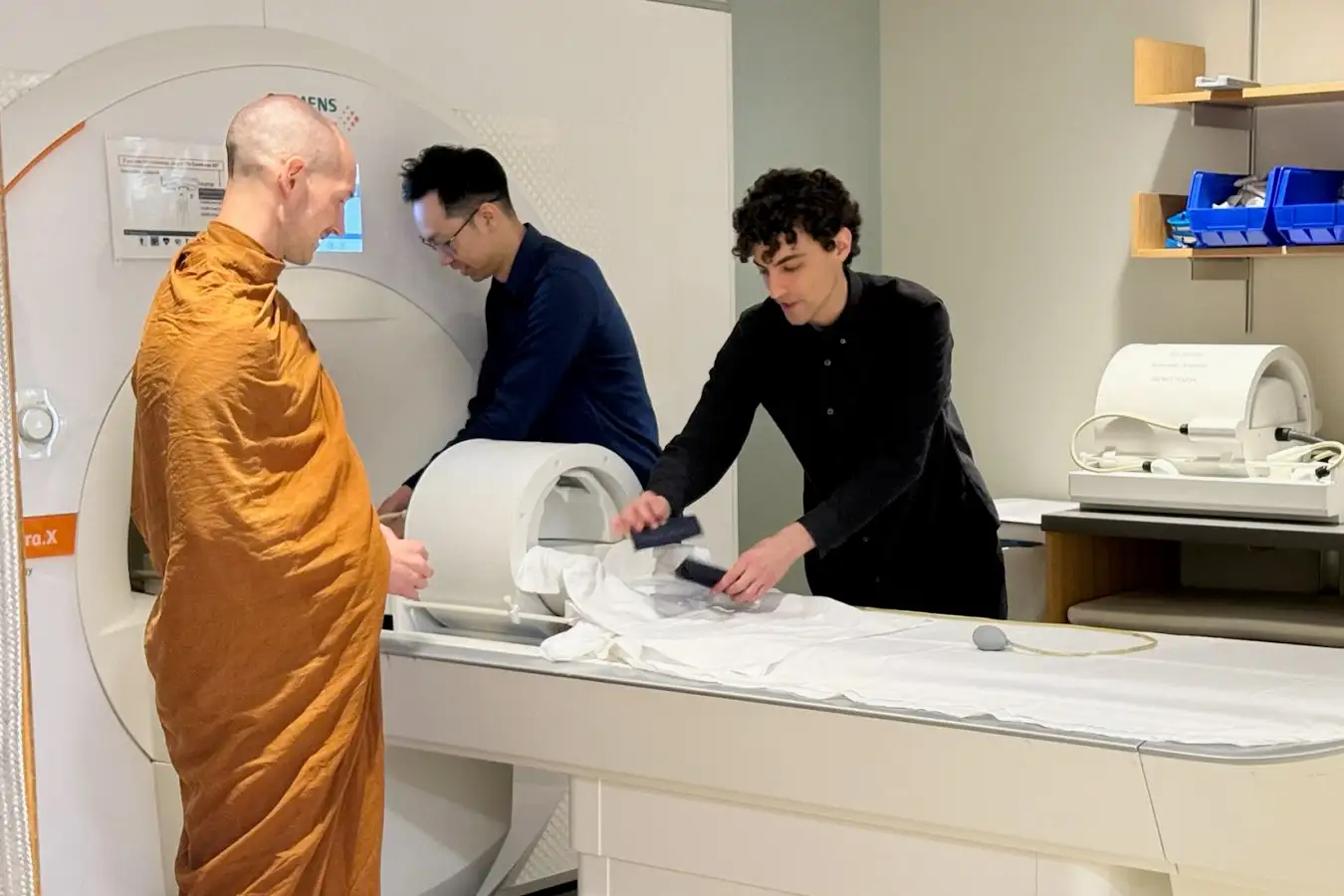
Chunyip Wong/Getty Images
Many of us have downloaded mindfulness apps like Headspace or Calm, and have probably benefited from spending 10 minutes each day focusing on our breathing. But reducing stress and softening the sharper edges of anxiety in this way are beginners’ steps when it comes to the practice of meditation.
Put in the hours, though, and you may well reach the deep end: a place where radical, long-lasting upgrades to how you feel and what you experience are possible. This reality has long been known by full-time contemplatives spending their lives in monasteries and caves. Now, these mental transformations are being examined and understood by neuroscientists at world-leading institutions.
At the frontier of this new wave of research is Matthew Sacchet, director of the Meditation Research Program at Harvard Medical School. His team works hand in hand with advanced meditators, such as Buddhist monks, exploring how the material brain changes because of subjective experiences that are often considered spiritual in nature.
Using state-of-the-art brain scanners, his team pinpoints the neural changes that occur across a variety of deep meditative practices – and investigates what the lasting impacts are.
Speaking to New Scientist, he explains how devoted meditation practice can rewrite experiences of emotion and physical pain, what extreme altered states can teach us about the nature of consciousness, and the technological possibilities of bringing these advanced practices to more people.
Claudia Canavan: On your lab’s website, it says: “We believe that scientific research has only scratched the surface in exploring the potential of meditation.” Can you elaborate?
Matthew Sacchet: There’s been a lot of research on mindfulness, generally defined in this context as non-judgmentally and intentionally paying attention to experiences of the present moment, and how it can be applied to reduce stress and psychological symptoms like anxiety. Far less research has investigated what we call advanced meditation, which involves deeper, ongoing mastery of practice that includes altered mental states – and even transformations of conscious experience and ways of being. Our research programme studies this mastery of meditation and asks: what are the limits of meditation? What’s possible beyond mindfulness?
What sort of things do you think are possible?
What’s possible with advanced meditation is quite profound. Beyond mindfulness-related stress reduction, advanced practitioners report experiences of ecstatic bliss, deep insights into their own minds, radical compassionate states and prosocial ways of being, and even shifts in their fundamental sense of self. Advanced meditators sometimes report states of consciousness that are described as deeply peaceful, mentally clear or subjectively non-dual – meaning there is no perceived distinction between self and other.
These aren’t just subjective reports: we observe changes in the brain that support their existence. It’s also important to note that advanced and long-term meditation seem to have the capacity to foster enduring well-being. In that sense, meditation becomes not just a temporary tool for feeling a little bit better, but a powerful pathway to human flourishing.
How does meditation impact how we feel emotions and physical pain?
In a recent review, along with my team at Harvard Medical School and Massachusetts General Hospital, and including collaborators from the University of Arizona, Sorbonne University and the Massachusetts Institute of Technology, we evaluated the scientific literature related to cognition in long-term meditators who have at least 1500 hours of meditation experience, reflecting consistent daily practice over several years.
We identified a number of patterns across these studies: for instance, long-term meditation seems to change how sensations and emotions are processed, which can impact everyday experiences. Many of these effects are associated with brain systems involved in what our minds pay attention to, which can alter our experience of pain, how we make sense of that information in relation to ourselves and how we regulate our emotions. These brain systems include the salience network, default mode network and affective network, which includes the amygdala, a brain region implicated in processing fear, anxiety and aggression.
One particularly important insight was that long-term meditators may not rely primarily on “top-down” cognitive control – as one might expect from traditional views of self-regulation, in which higher-level brain regions guide us towards our long-term goals. Instead, long-term meditators seem to display more automatic, “bottom-up” forms of brain processing that are more rooted in sensory information. This suggests that their brains may be altered to respond more intuitively and efficiently to emotions and sensations, rather than needing to engage the brain’s deliberate control mechanisms each time.

Matthew Sacchet (right) prepares an fMRI brain scanner to study the neural activity of a Buddhist monk (left)
Matthew D. Sacchet
The ideas you are exploring are often coded as “spiritual” and might seem outlandish to some. Why do you think the scientific community has begun to accept these as research questions?
With the mainstreaming of mindfulness science and psychedelic science, and developments in cognitive neuroscience, there’s also growing acceptance of going deeper into the mind in ways that historically have been seen as untouchable from a scientific perspective. There are so many crises facing modern society – in mental health, climate, economy, religion and politics – that I believe have contributed to more openness for potential solutions. The challenge that we have in this space is threading the needle between using the best scientific methods and studying phenomenon that have been historically relegated to the spiritual or the religious.
What are the practical challenges of this research? I’m guessing that asking someone to meditate deeply while hooked up to a brain scanner in a laboratory isn’t that easy…
It’s difficult to find individuals who can reliably access advanced meditative states in a controlled research environment. In practice, we take a lot of time with each meditator before they even come to our brain imaging centre. We educate participants on the data collection environment, what they can do to prepare for their time with us and the protocols that we’ll ask them to complete – all so that there are fewer surprises during data collection.
What kinds of radically altered states of mind can you study in this way?
One type is what we call advanced concentrative absorption meditation, which includes a series of states of deep concentration that have been called jhānas in some schools of Buddhism. These are reported to arc from bliss to peace to deep stillness and eventually equanimity – an even-minded state of calmness and composure. Other cultures and traditions report similar meditation experiences that are also characterised by specific attentional qualities, intense concentration and reduced visual, auditory and bodily sensations.
We’ve found that absorption practice induces complex changes in the brain, specific to the given states. The neuroscientific picture is still complex, but there is consistency in how these states appear in the brain across individuals who access them. One example is that, during absorption, we observe a shift in brain activity from the front parts to the back parts of the brain. This maps onto the reported experiences of the meditators, which relates to reduced top-down cognitive control and how that shapes perception.
Can these altered states tell us anything about the nature of consciousness?
Studies of long-term meditators suggest that what we experience as a fixed self may be more fluid than previously understood. Neuroimaging studies show that significant alterations in brain activity – for instance, in those regions related to attention, bodily awareness and self-related processing – are linked to practitioners’ subjective reports of altered experiences.
What we call cessation events, a type of meditative endpoint, could also help us to understand what consciousness is. Cessation of consciousness is described as a dramatic and brief event that can occur during advanced meditation, such as when someone has mastered advanced investigative insight. It involves a momentary complete absence of conscious experience. Some describe the onset of this event as a sort of falling away, or dissolution, of experience itself. With the return of consciousness after cessation, meditators report profound mental clarity and equanimity. Extended cessations that can last several days also happen. Cessation might sound similar to the experience of emerging from deep sleep, but cessation reports from advanced meditators are distinct, as they involve truly exceptional degrees of peace and lucidity.
As well as the absence of consciousness, advanced meditation includes highly refined or subtle forms of consciousness that we systematically compare in brain scanners, allowing us to isolate neural features unique to these different aspects of consciousness. This can help us understand the edges and limits of human experience.
Are these cessation events similar to the idea that advanced meditation can, ultimately, allow you to “transcend suffering”?
Yes. We call this the study of meditative endpoints, or major milestones of practice that may include major, persistent shifts in experience and ways of being. This is a sort of holy grail for our research.
Meditative endpoints, including what might be called “transcending suffering”, appear to go by different names in different traditions like Buddhism, Hinduism and Christianity, including “enlightenment”, “awakening” and “salvation”. If we can understand these phenomena, that would be an incredible step for science and, I believe, for humanity.

Matthew Sacchet (left) attaches an EEG headset that can monitor brain activity during states of deep meditation
Matthew D. Sacchet
In our initial research on this topic, we’re seeing that different traditions emphasise different qualities, experiences and beliefs related to these meditative endpoints. These might include an emphasis on ways of being in which you no longer experience negative emotions or stress, or alternatively, if negative emotions do arrive, then perhaps they do not capture attention and lead to suffering. Other traditions emphasise meditative endpoints that involve an experience of non-duality, or ways of being that have no experiential distinction between “self” and “other”. People who experience increasing levels of non-duality report that they experience a more peaceful and free way of being.
How long does it take to reach such extreme states of mind?
Meditative endpoints, for most people, are going to require considerable time and commitment. But there are individual differences in meditative capacities and also anecdotal reports of spontaneous events. We have studied some deep practitioners with only hundreds of hours of practice, whereas others may need far more experience before advanced meditation. Think of it like how some people can do 10 pull-ups without any training and others can’t do a single one.
Still, I think this path is valuable, even if one doesn’t experience such a meditative endpoint. For example, we study eight jhāna absorption states and different “lighter” and “deeper” forms of each. Experiencing a lighter form of the initial jhāna alone could be very powerful and may not take very long to learn.
How do we know such changes are real?
There may always be at least some concern about fabrication when conducting research using subjective, self-reported phenomena. But we conduct extensive interviews to better understand the experience of our research participants. And we are inclined to believe that people can, in fact, know and report on their experiences, even the deep experiential aspects of advanced meditation.
Our neuroscientific research already shows that advanced meditation is real in the sense that these experiences track meaningfully to brain measurements, and are distinct from what we’d see in the brains of people under anaesthesia or who are asleep or on psychedelics. That’s compelling evidence for something deeper going on here than mere confabulation.
How do you hope to make advanced meditation more available to people?
The first step is to make the concepts underlying advanced meditation more accessible. This includes informing people that there really is something there, something beyond mindfulness, and that it has radical potential. Exploring how we might democratise access to advanced meditation is key for us. One of the goals of our research is to meet people where they are, so they can benefit from advanced meditation.
This might simply involve teaching with clear verbal instructions, but there is also potential to explore more sci-fi ideas, like using neurotechnology. Neuromodulation technologies can use electrical or magnetic stimulation to locally excite or inhibit brain activity. An important open question is whether such interventions can facilitate advanced meditation, a question that may be informed by our research on the neural hallmarks of these experiences. There are a lot of challenges and ethical questions related to this, of course.
Topics:
Source link : https://www.newscientist.com/article/2501144-what-were-learning-about-consciousness-from-master-meditators-brains/?utm_campaign=RSS%7CNSNS&utm_source=NSNS&utm_medium=RSS&utm_content=home
Author :
Publish date : 2025-11-05 16:00:00
Copyright for syndicated content belongs to the linked Source.






